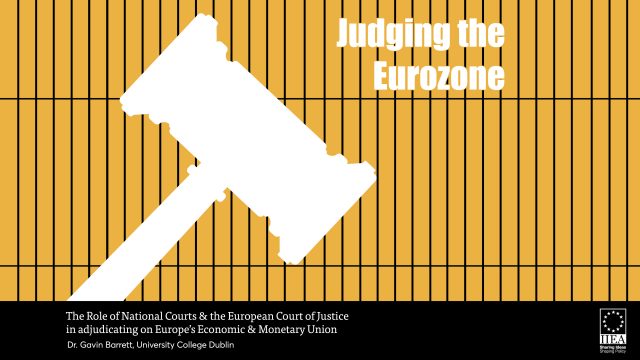Judging the Eurozone: The Role of National Courts and the European Court of Justice in adjudicating on Europe’s Economic and Monetary Union

Author: IIEA
Much of the EU’s constitutional evolution from the foundation of the single currency two decades ago to the present day has centred on Economic and Monetary Union (EMU). In the years following the onset of the sovereign debt and banking crises in the EU, the European Court of Justice (ECJ) was regularly called into action to adjudicate on matters pertaining to EMU, with important consequences for our present moment.
In a new research paper for the IIEA, Professor Gavin Barrett of the UCD Sutherland School of Law notes that crisis-era ECJ rulings concerning general Eurozone developments necessitated rapid constitutional development of the EU’s legal and institutional frameworks. For example, the ECJ upheld the establishment of the European Stability Mechanism (ESM) in Pringle and confirmed the legality of the ECB’s Outright Monetary Transactions programme in Gauweiler.
Overall, cases such as these have seen the ECJ shift towards a more discretionary and interventionist role for institutions like the ESM and the ECB. Professor Barrett observes, however, that the ECJ has generally been reluctant to play an activist role in the “political minefield” of economic policymaking, most often deferring to the political process. This implies less trust in the efficacy of a rigidly literal rules-based approach to EMU governance and this pattern has endured into the post-crisis period.
The ECJ has not been the only judicial body called upon to adjudicate on EMU since the sovereign debt and banking crises. As Professor Barrett details, national courts across the Eurozone have also dealt with general challenges to EMU measures. Some cases have concerned procedural or substantive challenges to actions taken to rescue the Eurozone during the crisis. These cases often involved arguments that the ‘architecture’ of the measures used were in violation of national constitutional identity, constitutional sovereignty clauses or constitutional guarantees of democratic legitimacy.
Other cases have involved challenges to the legality of bailouts, or the compatibility of measures used to implement bailout agreements with national constitutions. Many national court challenges focused on the constitutionality of austerity measures such as cuts to pay, social welfare benefits and pensions. Challenges of this nature were seen in Cyprus, Greece, Hungary, Ireland, Latvia, Portugal, Romania, Spain. The role of the International Monetary Fund in several bailout programmes also brought an international law aspect to some of these cases.
In the paper, Professor Barrett draws some generalisable lessons from national rulings on EMU matters. For example, he notes that the role of the national courts has generally been limited. National courts displayed considerable deference to the political process in both ‘architecture’ and ‘bailout’ cases, allowing the other branches of Government to take the lead. However, there have occasionally been significant individual judicial interventions.
Professor Barrett notes also that Eurozone rulings in national courts have been deeply contested within national legal systems. Just as significant constitutional development took place in the EU in the aftermath of the crisis, these contentious rulings have on occasion facilitated considerable development in national constitutional jurisprudence.
This paper can be accessed here.
